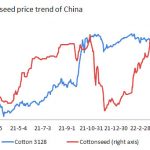
With regard to the export of cotton, the country faces a very strange and tricky situation every year making the government’s decision irrelevant and unacceptable to the stakeholders – cotton producers, ginners, cotton traders and the consuming industries like spinning mills, yarn traders, power looms, composite mills and of course exporters and importers of these materials including raw cotton. The government and others involved in policy making get sandwiched between two groups whose vested interests are diagonally opposite irrespective of the fact whether the export is allowed or banned. I feel that this makes a very interesting as well as important case study for our premier institutes of management. Their in-depth study of various aspects of this complex situation can help the government to strike a balance between various stake holders and ensure that the farmers get their fair and assured returns and unscrupulous hoarders get punished. The consuming mills should also not blow up their price concerns just to make more profits or cover up their inefficiency. The middlemen also need to be monitored so that they are not able to exploit the farmers who lack business acumen to deal with the buyers of their produce.
There is a growing feeling among the farmers’ bodies that farmers should have the freedom to market their produce wherever there is demand within and outside the country and the entire country should be treated as a single market. This sounds quite logical in the current era of free market. The ban on cotton exports to protect the powerful textile lobby only helps the textile mill owners who want cheap raw material to increase their profit margins. In view of good demand for cotton in the global markets if farmers want to export their produce to earn some money then it is should not pinch anybody. In any case there is no control on the prices of cloth and garments being sold in the country. Let there be an in-depth study and everybody know the cost structure of cotton farmers and mills. Let each stake holder’s business model be studied to bring out the real facts.
The USDA estimates that world cotton consumption is expected to increase 1.1% in 2016/17 to 112.5 million bales. It expects 2% decline in use in India, caused in part by the demonetization policy, coupled with the long-term trend of declines in East Asia and developed countries. The consumption outside of China is expected to remain flat.
We must accept that export restrictions have been a major factor contributing to cotton growers’ misery in all the major cotton producing States who are denied sustainable prices for their produce. They also face export ban when prices in the international market are rewarding. The ban goes against the farmers’ interests. It only benefits the organized sector mills who face high international prices in addition to shortage of the commodity.
The different stakeholders have different demands depending upon their vested interests.The government must see that no one takes undue advantage of the policies which must be formulated considering the farmers’ interests on top of everything else. Let every stake holder accept this basic point. If everyone, except the farmer, is making money in the value chain then isn’t it shameful for the government and the civil society?
G.D. JASUJA
Managing Editor





